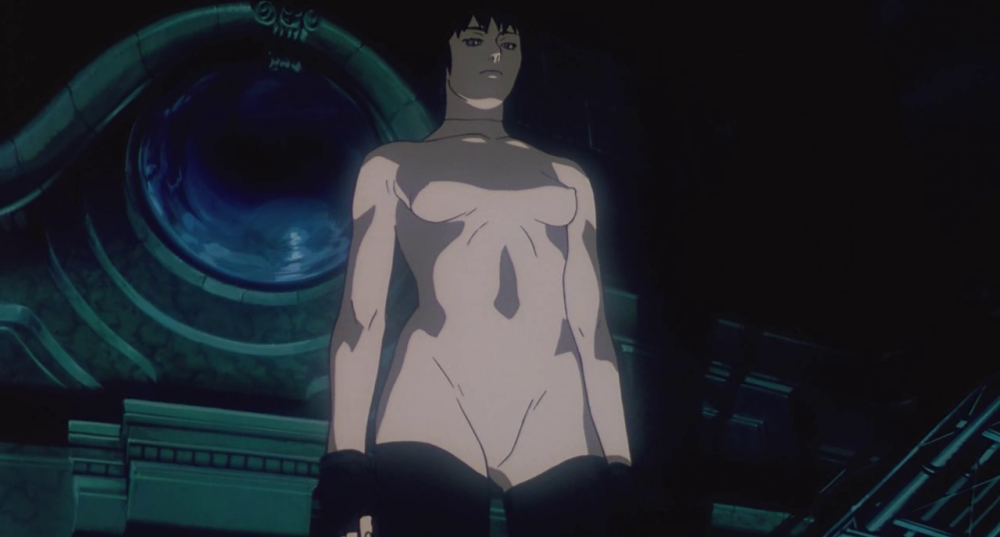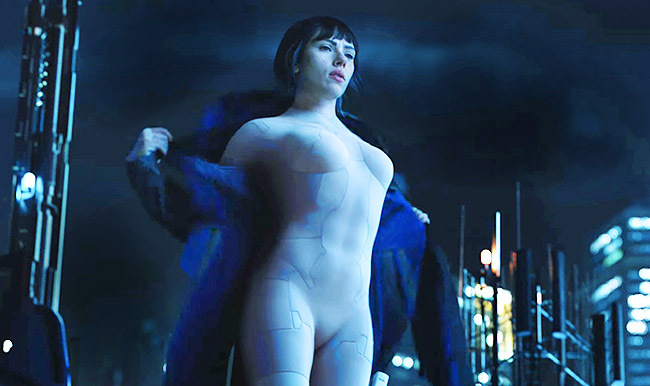The Ghost in the Shell franchise has enjoyed many iterations over the years, each one depicting lead character Motoko Kusanagi in various stages of undress. In some cases, this has related to the overall themes and philosophy of the work. Other times, not so much. This has me wondering: How will the new film, starring Scarlett Johansson and releasing on March 31 in the United States, depict its lead female?
The 1995 Ghost in the Shell animated film — the first exposure to the franchise for most in the U.S. — manages to depict its main character as nude or semi-nude throughout without sexualizing her. She is often filmed from a low angle, emphasizing her power and authority. Her sole vulnerability is an existential crisis, in that she is constantly in the process of examining her own psyche, wondering if her transition to a cyborg body robbed her of humanity. By portraying a woman in this way, with so few concessions to a male audience, the original film functions as a important example of feminist film and an intriguing look at what it means to be a woman (or, more broadly, a human) free from sexuality. It wrapped all this up in an incredible work of sci-fi existentialism.

Major Kusanagi as she appears in the 1995 film
The subsequent anime series, Stand Alone Complex, tackles some intriguing themes but constantly depicts Motoko in an extremely sexualized bathing suit-like outfit (in a police work environment, no less) and is filled with every variety of gratuitous, sexualized nonsense the directors had at their disposal. Unlike the original film, the camera is nothing more than a stand-in for the male eye. Though Motoko is never nude, she is more eroticized in her bathing suit outfit than she ever was in the original film. Interestingly, though, the sexualization is only visual. Motoko is treated seriously in every other way; if one were to read the dialogue without seeing the animation, there would be no indication of the ridiculous outfit or the camera’s single-minded focus on her body. This attempt to have it both ways — catering to a horny male audience while telling a serious story about a female lead character — makes every scene unintentionally hilarious. While the series can sometimes reach impressive depths of emotion and intelligence, its failure to reign in the visual treatment of its lead character cannot be ignored.

A shot from Stand Alone Complex
Then there’s the original manga (Japanese comic book, for the uninitiated). Despite being the source of most of the 1995 film’s philosophical underpinnings, it included an undeniably pornographic two-page spread of Motoko engaged in a lesbian orgy.
So…in theory, both approaches could work in a feminist film. A woman “free” from sex and a woman who likes-sex-very-much-thank-you-may-I-have-some-more both deserve to be depicted in film with equal respect. But so far, I’m inclined to say the former tack is more successful, with the exception of rare films like David Fincher’s Girl with the Dragon Tattoo. Usually, when a film says it’s doing the latter, what it’s actually doing is knowingly titillating the audience and reducing feminine rebellion or independence to “look how little clothing I can wear and not even care! Wooo!” In other words, a woman’s “strength” becomes inextricably tied to her sex appeal. For a film to successfully depict a woman who is also a sexual being, it needs to shed the male eye, and this is depressingly rare.
There is, of course, a third path filmmakers have attempted: Depict a woman as strong mentally or emotionally, but avoid any hint of sex appeal by any means necessary — cast an older actress, apply a mask of “uglifying” makeup, etc. This approach is wonderful if it feels unintentional and natural (in the BBC series “Broadchurch,” Olivia Colman’s character is a brilliant detective who is never sexualized, and it’s a breath of fresh air because you would never see her in an equivalent part in an American production, unless her part was about parenting or some other marginalizing role). But when it’s completely intentional, which happens more often, it can imply that womanhood, sexuality, and psychological strength should not or do not exist together in women for the purposes of film.
So, which approach will the new film take? We can rule one thing out already: Scarlett Johansson will not be “uglified.” She is a talented actress, but the trailers make it clear the film will not shy away from her sex appeal. Her body in the new film, an artificial shell that imitates a female body but does not approach the lifelike realism of her body in the original animated film, is an attempt to be faithful to the original’s nudity while maintaining broad market appeal. However, it clearly delineates an obvious physical difference between her and a person with a natural body, which may somewhat lessen the viability of the character as a metaphor for womanhood.
You see, the original film visually framed her existential conflict both as one between body and mind, and also between body and gender. What does the outward appearance of a female body actually mean? Is a mind gendered? She is even referred to at one point as an “Amazon,” an explicitly gendered reference to women of Greek myth who were said to alter their bodies (by cutting off a breast) to make it easier to wield a bow. And let us not forget that the film opens with a line that calls into question Motoko’s ability to menstruate in an artificial body.
In the upcoming film, however, the visual metaphor is dampened by the fact that the body screams, “fake!” Her central conflict will likely be more about the conflict between “real brain” and “fake body,” perhaps eliminating the gender slant altogether. Yet the nature of the body, alone, will not necessarily define the film’s approach. The film could conceivably tackle the body vs. gender issue by making her “fake” body the whole point.

The major’s cyborg body as it appears in the upcoming film (via Paramount)
We are left, then, to consider Hollywood’s track record, and the verdict isn’t good. Johansson’s “Black Widow” in the Marvel films is worryingly close to the portrayal of Motoko in Stand Alone Complex. While Widow is strong physically and psychologically, she wears a skin-tight outfit tailor-made for a male audience, and her role in the films is usually as a partner for one of the male heroes. Furthermore, the new Ghost cost almost $200 million; with that kind of investment, it’s safe to say director Rupert Sanders won’t be aiming for an existential character study. Sex appeal is a money-maker.
Thus, of the three approaches we started with, we are left with only one that could still lead to a successful film: a Motoko that is openly sexual, placed within a story that makes her question the relationship between her body and her gender. I’m not optimistic, but I am hopeful. If Hollywood pulls this off, it will be a miracle, but it doesn’t hurt to root for miracles once in a while.
I am really impressed with your writing skills as well as with
the layout on your blog. Is this a paid theme or did you customize it yourself?
Either way keep up the nice quality writing, it’s rare to see a
nice blog like this one today.
my web page: Pearline
LikeLike